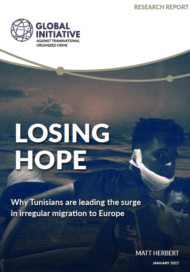Posted on 19 May 2022
Extortion is not only a driver of migration but also a pervasive danger faced by migrants on the move, particularly those who use people-smuggling services, and more needs to be done to address the vulnerabilities and structural challenges that underpin these two issues.
The International Migration Review Forum, which reviews the Global Compact for Safe, Orderly and Regular Migration, takes place from 17 to 20 May 2022. The Global Initiative Against Transnational Organized Crime (GI-TOC) participated in the multi-stakeholder hearing leading up to the meeting and focused on the impacts of extortion on migration dynamics.
Extortion is both a trigger of migration and a risk faced by irregular migrants on the move in various parts of the world. Despite its prevalence globally, however, extortion is often perceived as an isolated concern, and current analysis tends to focus only on certain origin countries and certain irregular migration routes, such as the Central America corridor. Cross-regional comparisons of the phenomenon are rare.
The GI-TOC’s Observatories of Illicit Economies in North Africa and the Sahel and in Central America have conducted extensive research on extortion and its role in migration, and the findings illustrate the complex risks and challenges extortion poses – in these regions and beyond.
Central America
In Central America, which experiences structural problems such as corruption, impunity and distrust towards failing security and justice institutions, extortion has become one of the key drivers for internal displacement and cross-border migration. In areas where gangs have territorial control, extortion is used a means to exert criminal authority through violence and the threat of it. Nobody is exempt – gangs target individuals, small businesses and large companies.
In this region extortion is a form of criminal governance that exacerbates the root causes of migration, including poor economic growth and development, failures in public safety and the erosion of community resilience. Extortion disrupts entire industries, such as the public transport and delivery sectors, and affects individual families. In some gang-controlled territories, children are forced to pay extortion fees in order to get safely to school and sexual favours are demanded from women when their family fails to make payments.
Along migration routes, and once they have reached their destination, gangs often threaten migrants using social media or messaging apps, demanding payments to ensure the safety of family members at home. This creates an atmosphere of continual insecurity and acts as a further incentive for whole families to migrate.
The cycle needs to be broken. However, institutional responses to extortion in Central America are hindered by corruption in the authorities, impunity and lack of resources. In some countries, such as Guatemala and Honduras, there have been efforts to create special judicial units to act as anti-extortion tribunals, but they are faced with overwhelming caseloads, and lack adequate protocols to protect and support victims.
North Africa and the Sahel
According to GI-TOC research conducted in Niger, Chad and Libya, extortion is a key danger faced by irregular migrants in transit. In the human smuggling industry in the region, there is a blurred line between apparently voluntary transactions (i.e. payments for a smuggling service) and extortionary crimes. The latter manifest in three ways: victimization by human smuggling networks, targeting by groups focused on extortion and monetization by security forces.
The price of and ways of paying for human smuggling services are the first factor contributing to the vulnerability of migrants to extortion. Many migrants travelling through Niger or Chad to Libya cannot afford to pay for their journey upfront and resort to paying in instalments or travelling on credit. For those paying in instalments, there is routine risk that upon arrival in Libya they may be held in captivity, as smugglers demand a previously agreed second payment and sometimes increase their fees.
Migrants travelling on credit face even more risk, with some such payment approaches requiring a period of indentured labour, leaving migrants vulnerable to trafficking and extortion of labour. This can take place on arrival in Libya but also in transit areas, such as goldfields in northern Chad and, to a lesser extent, northern Niger.
The second extortionary risk facing migrants comes from kidnap-for-ransom gangs, which hold migrants against their will and torture them for payment and release. The kidnap-for-ransom industry is most developed in Libya, prevalent near logistical hubs for human smuggling, such as Bani Walid or Shwayrif. The ready supply of migrants to be kidnapped or bought, the relative lawlessness prevailing in the country, and the crossover between some smuggling networks and extortion gangs make these hubs places of risk for migrants. It is important to note that kidnap-for-ransom gangs working in Libya are not exclusively Libyan – victims are often held by nationals from their own countries.
The risk of kidnap for ransom is lower in Niger and Chad, although this may be changing. Government efforts there to counter human smuggling mean that irregular migrants are transported through increasingly remote routes to bypass security checks. Migrants using these new routes are prone to armed banditry attacks, which have increasingly targeted human smuggling convoys. In addition to simple robbery, attacks can result in extortion of smugglers and migrants and/or the kidnapping of migrants for ransom.
Extortion of migrants is also practised by state-affiliated security forces in Libya. The detention centres nominally run by the Department for Combating Illegal Immigration in western Libya are often controlled by local armed groups. Migrants held in these facilities can pay to be released. This can be seen as bribery and is often related to human smuggling, with networks connecting the centres, Libya’s coast guard and maritime smugglers. However, the bribery becomes extortion when those controlling the detention centres round up migrants from the street with the explicit intention of forcing them to pay for their release. Migrants rounded up this way by security forces nominally upholding migration laws may also be sold back to smugglers or trafficked for sex work.
Looking ahead
Given the fear and distrust that extortion engenders among communities and towards authorities, it is vital to create spaces for dialogue in which stakeholders and victims can understand the risks faced. De-normalizing extortion practices and supporting communities’ needs are essential. By raising awareness of extortion risks among migrant communities, ad hoc responses can be created.
Institutions are often constrained by lack of resources needed to fully understand and respond to extortion. This is due to weak capacity and, in particular along migration routes, because crimes can span multiple legal jurisdictions. In the Sahel, for example, predatory agreements struck with migrants in Chad to transport them on credit to Libya may result in extorted labour in the latter country, complicating responses.
To assist official responses, it is key to build the knowledge base of state agencies to better understand and investigate extortion, and bring perpetrators to justice. Developing solutions-oriented research, as well as improving data quality and availability, is of the outmost importance for achieving this task. Finally, cross-national and regional approaches must be further developed in order to address the issue.



